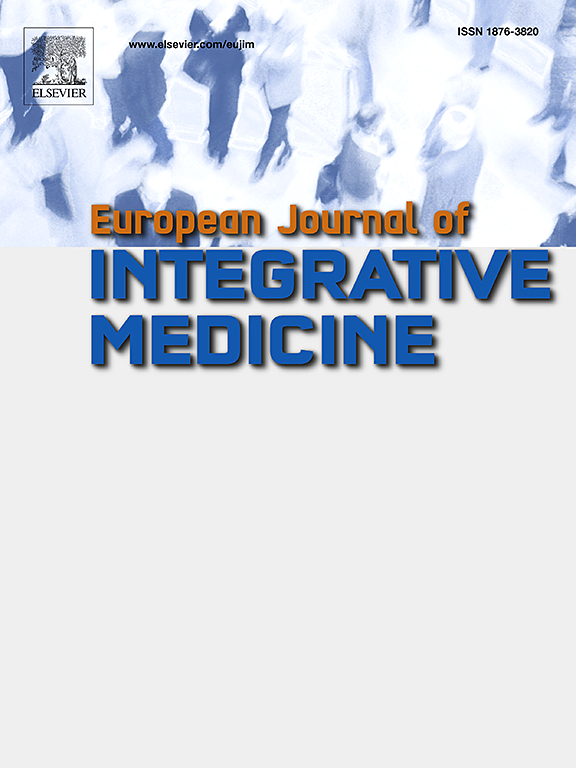中医辨证对原发性失眠重要吗?采用匹配重组、间接比较和网络元分析的探索性综述
IF 1.7
4区 医学
Q3 INTEGRATIVE & COMPLEMENTARY MEDICINE
引用次数: 0
摘要
辨证论治是中医诊断和治疗疾病的主要方法,已成为针灸临床发展的关键。然而,辨证论治对针灸治疗效果的影响,缺乏临床证据的支持。因此,我们旨在通过重新分析针灸治疗原发性失眠的试验结果,评估辨证取穴的重要性。方法系统检索9个数据库,筛选符合条件的试验。两位作者独立地从引文、干预措施和结果中提取数据。由于本研究比较的“治疗针灸”和“对照针灸”数据来自不同的试验,我们以1:1的比例匹配数据,尽量减少配对组之间的异质性。匹配因素包括年龄、性别比例和基线匹兹堡睡眠质量指数(PSQI)得分。采用Revman 5.4软件进行meta分析。采用STATA 15.0进行网络meta分析。效应估计提供了具有95%置信区间(CI)的标准平均差(SMD)的连续数据。结果共纳入172项试验。匹配后,共建立19对重组研究。对19对患者进行meta分析,辨证组PSQI评分低于非辨证组(SMD: -0.87, 95% CI -1.46 ~ -0.28, P = 0.004)。所有纳入试验的网络荟萃分析显示,辨证与非辨证在选穴上无统计学差异(SMD: -0.40, 95% CI -2.63 ~ 1.84)。但根据SUCRA曲线,辨证取穴(43.9%)高于非辨证取穴(38.0%)。结论目前证据尚不能完全支持辨证针刺治疗原发性失眠优于非辨证针刺治疗。虽然在匹配的研究中观察到统计上显著的大效应量,但由于方法学的局限性、异质性和分析方法的结果不一致,这种差异的临床相关性仍然不确定。未来的试验需要直接比较和标准化的结果测量来阐明针灸治疗中辨证的临床应用。本文章由计算机程序翻译,如有差异,请以英文原文为准。
Is traditional Chinese medicine syndrome differentiation important in primary insomnia? An exploratory review with matching recombination indirect comparisons and network meta-analysis
Introduction
Syndrome differentiation is the primary method of Traditional Chinese Medicine (TCM) diagnosis and treatment of diseases and has become the key to the clinical development of acupuncture. However, there is a lack of supporting clinical evidence to determine the impact of syndrome differentiation on the efficacy of acupuncture treatment. Therefore, we aimed to evaluate the importance of point selection based on syndrome differentiation by re-analyzing the trials' results in treating primary insomnia with acupuncture.
Methods
We systematically searched 9 databases for eligible trials. Two authors extracted data independently from citations, interventions, and outcomes. Since the "treatment acupuncture" and "control acupuncture" data compared in this study were from different trials, we matched the data in a 1:1 ratio and minimized heterogeneity between the paired groups. Matching factors included age, sex ratio, and the baseline Pittsburgh Sleep Quality Index (PSQI) score. Meta-analyses were performed using Revman 5.4 software. STATA 15.0 was used for the network meta-analysis. Effect estimation presented continuous data with a standard mean difference (SMD) with a 95 % confidence interval (CI).
Results
We included a total of 172 trials. After matching, 19 recombinational pairs of studies were established. Meta-analysis of the 19 pairs showed that PSQI scores in the syndrome differentiation group were lower than the non-syndrome differentiation group (SMD: -0.87, 95 %CI -1.46 to -0.28, P = 0.004). Network meta-analysis of all included trials showed no statistical difference in acupoints selection between syndrome and non-syndrome differentiation (SMD: -0.40, 95 % CI -2.63 to 1.84). However, acupoint selection based on syndrome differentiation (43.9 %) ranks higher than acupoint selection based on non-syndrome differentiation (38.0 %) according to SUCRA curves.
Conclusions
Current evidence does not conclusively support the superiority of syndrome differentiation-based acupuncture over non-syndrome differentiation for primary insomnia. While statistically significant large effect size was observed in matched studies, the clinical relevance of this difference remains uncertain due to methodological limitations, heterogeneity, and inconsistent findings across analytical approaches. Future trials with direct comparisons and standardized outcome measures are needed to clarify the clinical utility of syndrome differentiation in acupuncture therapy.
求助全文
通过发布文献求助,成功后即可免费获取论文全文。
去求助
来源期刊

European Journal of Integrative Medicine
INTEGRATIVE & COMPLEMENTARY MEDICINE-
CiteScore
4.70
自引率
4.00%
发文量
102
审稿时长
33 days
期刊介绍:
The European Journal of Integrative Medicine (EuJIM) considers manuscripts from a wide range of complementary and integrative health care disciplines, with a particular focus on whole systems approaches, public health, self management and traditional medical systems. The journal strives to connect conventional medicine and evidence based complementary medicine. We encourage submissions reporting research with relevance for integrative clinical practice and interprofessional education.
EuJIM aims to be of interest to both conventional and integrative audiences, including healthcare practitioners, researchers, health care organisations, educationalists, and all those who seek objective and critical information on integrative medicine. To achieve this aim EuJIM provides an innovative international and interdisciplinary platform linking researchers and clinicians.
The journal focuses primarily on original research articles including systematic reviews, randomized controlled trials, other clinical studies, qualitative, observational and epidemiological studies. In addition we welcome short reviews, opinion articles and contributions relating to health services and policy, health economics and psychology.
 求助内容:
求助内容: 应助结果提醒方式:
应助结果提醒方式:


